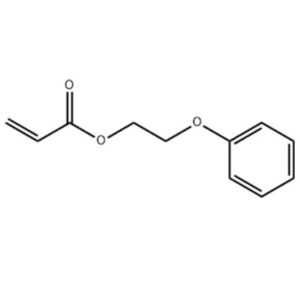| Polythiol/Polymercaptan |
|
|
| CHLUMICRYL®DMES Monomer |
Bis(2-mercaptoethyl) sulfide |
3570-55-6 |
| CHLUMICRYL® DMPT Monomer |
THIOCURE DMPT |
131538-00-6 |
| CHLUMICRYL® PETMP Monomer |
|
7575-23-7 |
| CHLUMICRYL® PM839 Monomer |
Polyoxy(methyl-1,2-ethanediyl) |
72244-98-5 |
| Monofunctional Monomer |
|
|
| CHLUMICRYL® HEMA Monomer |
2-hydroxyethyl methacrylate |
868-77-9 |
| CHLUMICRYL® HPMA Monomer |
2-Hydroxypropyl methacrylate |
27813-02-1 |
| CHLUMICRYL® THFA Monomer |
Tetrahydrofurfuryl acrylate |
2399-48-6 |
| CHLUMICRYL® HDCPA Monomer |
Hydrogenated dicyclopentenyl acrylate |
79637-74-4 |
| CHLUMICRYL® DCPMA Monomer |
Dihydrodicyclopentadienyl methacrylate |
30798-39-1 |
| CHLUMICRYL® DCPA Monomer |
Dihydrodicyclopentadienyl Acrylate |
12542-30-2 |
| CHLUMICRYL® DCPEMA Monomer |
Dicyclopentenyloxyethyl Methacrylate |
68586-19-6 |
| CHLUMICRYL® DCPEOA Monomer |
Dicyclopentenyloxyethyl Acrylate |
65983-31-5 |
| CHLUMICRYL® NP-4EA Monomer |
(4) ethoxylated nonylphenol |
50974-47-5 |
| LA Monomer |
Lauryl acrylate / Dodecyl acrylate |
2156-97-0 |
| CHLUMICRYL® THFMA Monomer |
Tetrahydrofurfuryl methacrylate |
2455-24-5 |
| CHLUMICRYL® PHEA Monomer |
2-PHENOXYETHYL ACRYLATE |
48145-04-6 |
| CHLUMICRYL® LMA Monomer |
Lauryl methacrylate |
142-90-5 |
| CHLUMICRYL® IDA Monomer |
Isodecyl acrylate |
1330-61-6 |
| CHLUMICRYL® IBOMA Monomer |
Isobornyl methacrylate |
7534-94-3 |
| CHLUMICRYL® IBOA Monomer |
Isobornyl acrylate |
5888-33-5 |
| CHLUMICRYL® EOEOEA Monomer |
2-(2-Ethoxyethoxy)ethyl acrylate |
7328-17-8 |
| Multifunctional monomer |
|
|
| CHLUMICRYL® DPHA Monomer |
|
29570-58-9 |
| CHLUMICRYL® DI-TMPTA Monomer |
DI(TRIMETHYLOLPROPANE) TETRAACRYLATE |
94108-97-1 |
| Acrylamide monomer |
|
|
| CHLUMICRYL® ACMO Monomer |
4-acryloylmorpholine |
5117-12-4 |
| Di-functional Monomer |
|
|
| CHLUMICRYL® PEGDMA Monomer |
Poly(ethylene glycol) dimethacrylate |
25852-47-5 |
| CHLUMICRYL® TPGDA Monomer |
Tripropylene glycol diacrylate |
42978-66-5 |
| CHLUMICRYL® TEGDMA Monomer |
Triethylene glycol dimethacrylate |
109-16-0 |
| CHLUMICRYL® PO2-NPGDA Monomer |
Propoxylate neopentylene glycol diacrylate |
84170-74-1 |
| CHLUMICRYL® PEGDA Monomer |
Polyethylene Glycol Diacrylate |
26570-48-9 |
| CHLUMICRYL® PDDA Monomer |
Phthalate diethylene glycol diacrylate |
|
| CHLUMICRYL® NPGDA Monomer |
Neopentyl glycol diacrylate |
2223-82-7 |
| CHLUMICRYL® HDDA Monomer |
Hexamethylene Diacrylate |
13048-33-4 |
| CHLUMICRYL® EO4-BPADA Monomer |
ETHOXYLATED (4) BISPHENOL A DIACRYLATE |
64401-02-1 |
| CHLUMICRYL® EO10-BPADA Monomer |
ETHOXYLATED (10) BISPHENOL A DIACRYLATE |
64401-02-1 |
| CHLUMICRYL® EGDMA Monomer |
Ethylene glycol dimethacrylate |
97-90-5 |
| CHLUMICRYL® DPGDA Monomer |
Dipropylene Glycol Dienoate |
57472-68-1 |
| CHLUMICRYL® Bis-GMA Monomer |
Bisphenol A Glycidyl Methacrylate |
1565-94-2 |
| Trifunctional Monomer |
|
|
| CHLUMICRYL® TMPTMA Monomer |
Trimethylolpropane trimethacrylate |
3290-92-4 |
| CHLUMICRYL® TMPTA Monomer |
Trimethylolpropane triacrylate |
15625-89-5 |
| CHLUMICRYL® PETA Monomer |
|
3524-68-3 |
| CHLUMICRYL® GPTA ( G3POTA ) Monomer |
GLYCERYL PROPOXY TRIACRYLATE |
52408-84-1 |
| CHLUMICRYL® EO3-TMPTA Monomer |
Ethoxylated trimethylolpropane triacrylate |
28961-43-5 |
| Photoresist Monomer |
|
|
| CHLUMICRYL® IPAMA Monomer |
2-isopropyl-2-adamantyl methacrylate |
297156-50-4 |
| CHLUMICRYL® ECPMA Monomer |
1-Ethylcyclopentyl Methacrylate |
266308-58-1 |
| CHLUMICRYL® ADAMA Monomer |
1-Adamantyl Methacrylate |
16887-36-8 |
| Methacrylates monomer |
|
|
| CHLUMICRYL® TBAEMA Monomer |
2-(Tert-butylamino)ethyl methacrylate |
3775-90-4 |
| CHLUMICRYL® NBMA Monomer |
n-Butyl methacrylate |
97-88-1 |
| CHLUMICRYL® MEMA Monomer |
2-Methoxyethyl Methacrylate |
6976-93-8 |
| CHLUMICRYL® i-BMA Monomer |
Isobutyl methacrylate |
97-86-9 |
| CHLUMICRYL® EHMA Monomer |
2-Ethylhexyl methacrylate |
688-84-6 |
| CHLUMICRYL® EGDMP Monomer |
Ethylene glycol Bis(3-mercaptopropionate) |
22504-50-3 |
| CHLUMICRYL® EEMA Monomer |
2-ethoxyethyl 2-methylprop-2-enoate |
2370-63-0 |
| CHLUMICRYL® DMAEMA Monomer |
N,M-Dimethylaminoethyl methacrylate |
2867-47-2 |
| CHLUMICRYL® DEAM Monomer |
Diethylaminoethyl methacrylate |
105-16-8 |
| CHLUMICRYL® CHMA Monomer |
Cyclohexyl methacrylate |
101-43-9 |
| CHLUMICRYL® BZMA Monomer |
Benzyl methacrylate |
2495-37-6 |
| CHLUMICRYL® BDDMP Monomer |
1,4-Butanediol Di(3-mercaptopropionate) |
92140-97-1 |
| CHLUMICRYL® BDDMA Monomer |
1,4-Butanedioldimethacrylate |
2082-81-7 |
| CHLUMICRYL® AMA Monomer |
Allyl methacrylate |
96-05-9 |
| CHLUMICRYL® AAEM Monomer |
Acetylacetoxyethyl methacrylate |
21282-97-3 |
| Acrylates Monomer |
|
| CHLUMICRYL® IBA Monomer |
Isobutyl acrylate |
106-63-8 |
| CHLUMICRYL® EMA Monomer |
Ethyl methacrylate |
97-63-2 |
| CHLUMICRYL® DMAEA Monomer |
Dimethylaminoethyl acrylate |
2439-35-2 |
| CHLUMICRYL® DEAEA Monomer |
2-(diethylamino)ethyl prop-2-enoate |
2426-54-2 |
| CHLUMICRYL® CHA Monomer |
cyclohexyl prop-2-enoate |
3066-71-5 |
| CHLUMICRYL® BZA Monomer |
benzyl prop-2-enoate |
2495-35-4 |
| Other Monomer |
|
|
| CHLUMICRYL® MCPMA Monomer |
1-Methylcyclopentyl Methacrylate |
178889-45-7 |
| CHLUMICRYL® TMPMP Monomer |
Trimethylolpropane Tris(3-mercaptopropionate) |
33007-83-9 |
| CHLUMICRYL® CTFA Monomer |
Cyclic Trimethylopropane Formal Acrylate |
66492-51-1 |
| CHLUMICRYL® HPHPDA Monomer |
|
30145-51-8 |
| CHLUMICRYL® MPEG Monomer |
|
26915-72-0 |







Liam Carter –
Swift delivery, exceptional quality. Couldn’t ask for more! Highly satisfied with my purchase.